My apologies for being so silent during the past month or so with only a couple of new articles posted. My wife and I have been on an extended holiday/photography tour for the past 26 days.
The purpose of this extended trip was to revisit some areas of the Western USA as well as take in some new sites, capturing some photographs along the way. This was field work for some photography-related books I have planned for early 2017 (more on that in the months ahead).
NOTE: Click on images to enlarge.

Our trip covered 10,187 kilometres with about 19 days of the journey focused primarily on photography. We had quite an aggressive schedule which was designed to replicate a typical sightseeing holiday that many travellers would experience.
We did not revisit sites on consecutive days waiting for ideal photography conditions. We simply took each day as it came and created whatever images we could on a ‘catch as catch can’ basis.
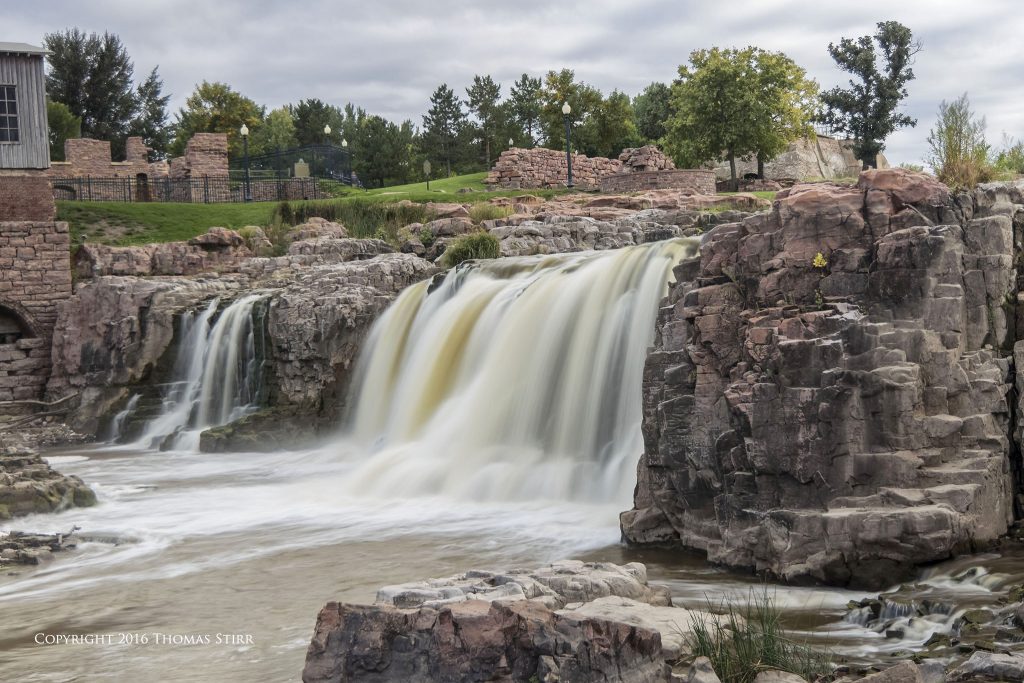
Our first planned photography stop was at Sioux Falls South Dakota. I used a Benro monopod and a variable neutral density filter to help capture the two waterfall images above.
Sioux Falls is a series of cascade type waterfalls which extend several hundred meters. I spent about an hour or so photographing various water features along the water course.

The next morning we headed off to Rapid City South Dakota with a planned afternoon stop at Badlands National Park, where the above image was captured.

We entered the park through the eastern end and made stops at the various overlook points. Without question it would be easy to spend a number of days at this splendid park with your camera.

We used Rapid City as our base for a few nights. The next day we headed out to the Crazy Horse Memorial, Mount Rushmore, Custer State Park, and the Needles Highway. If you look on the right side of the Crazy Horse Monument image you’ll be able to see the outline of the horse’s head.
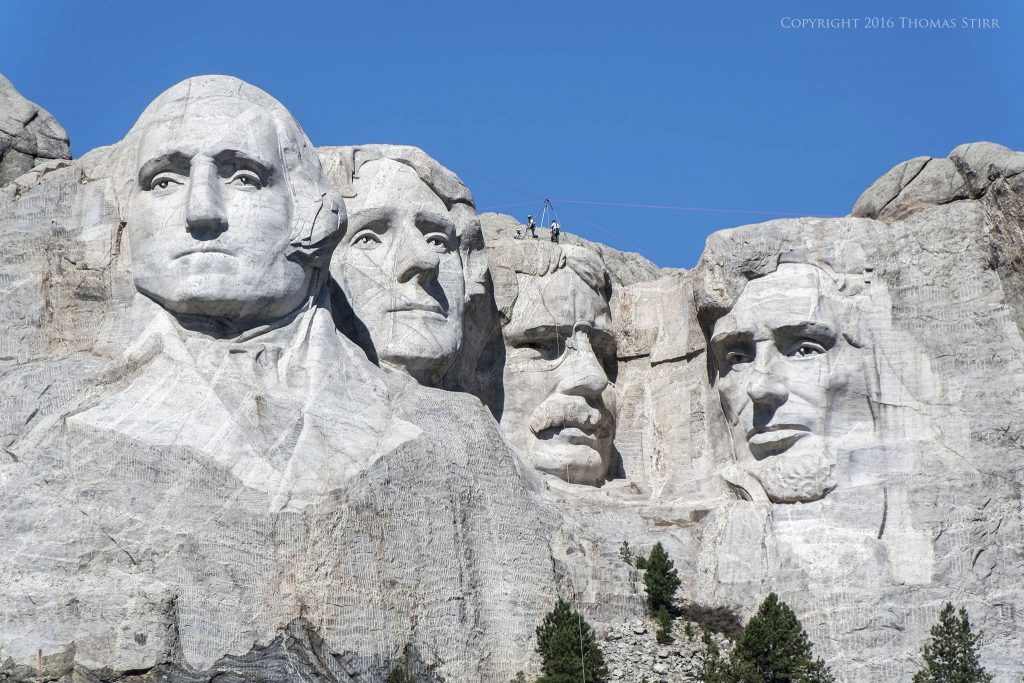
While at Mount Rushmore I noticed some workmen doing some maintenance on the top of the monument. I took a few images with my V2 and CX 70-300mm, then remounted the zoom lens on one of my J5s. It yielded the following image…
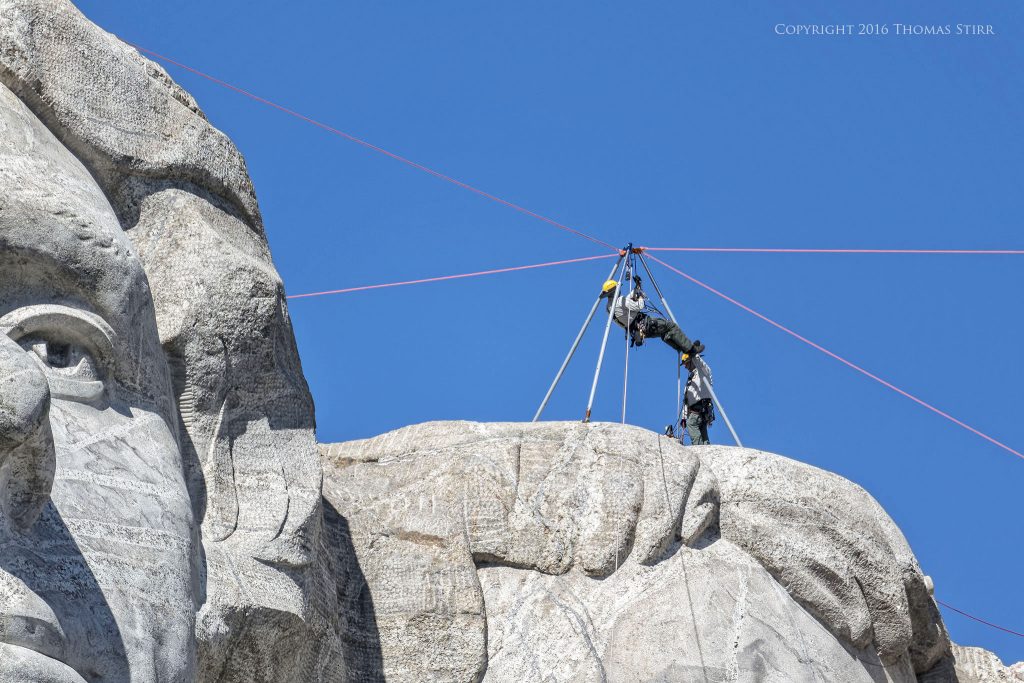
Watching these intrepid workers on the top of the monument made me wonder what kind of health insurance coverage is required!
While we didn’t get directly hit with too much rain during our photography tour, many days had quite menacing weather in our vicinity. This created overcast conditions on a number of days, while others had skies full of heavy, dark clouds.

The Needles Highway is named after the rock formation pictured above. We entered the roadway on the eastern end and it took quite a while before we reached the higher elevations where the ‘needles’ are located. The drive going up was actually pretty boring with very little to see other than the pavement and trees lining both sides of the road.
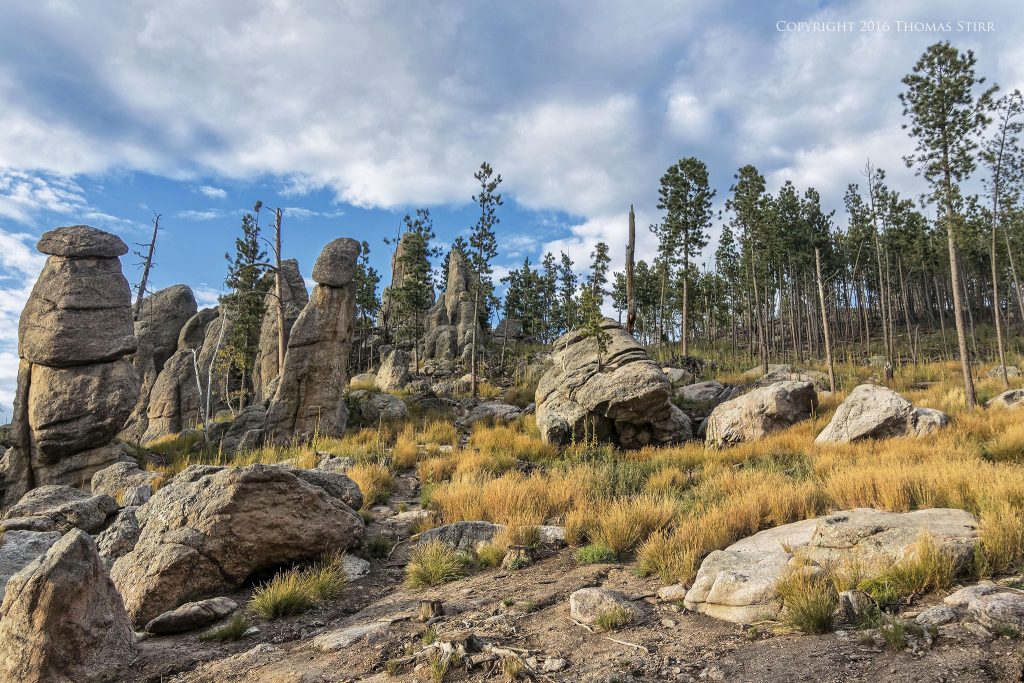
Once you are at the ‘needles’ area there are a number of other interesting rock formations and outlooks which make the drive worth the effort.
After another day photographing in the Rapid City area we headed off into Wyoming with planned stops at the Devil’s Tower and Yellowstone National Park.

Our schedule only allowed for one afternoon at Yellowstone. Once you get past Old Faithful and on towards the western end of the park there are many outstanding photo opportunities. If you are a photographer who also enjoys hiking you could easily spend a few days or even a week in this expansive park.
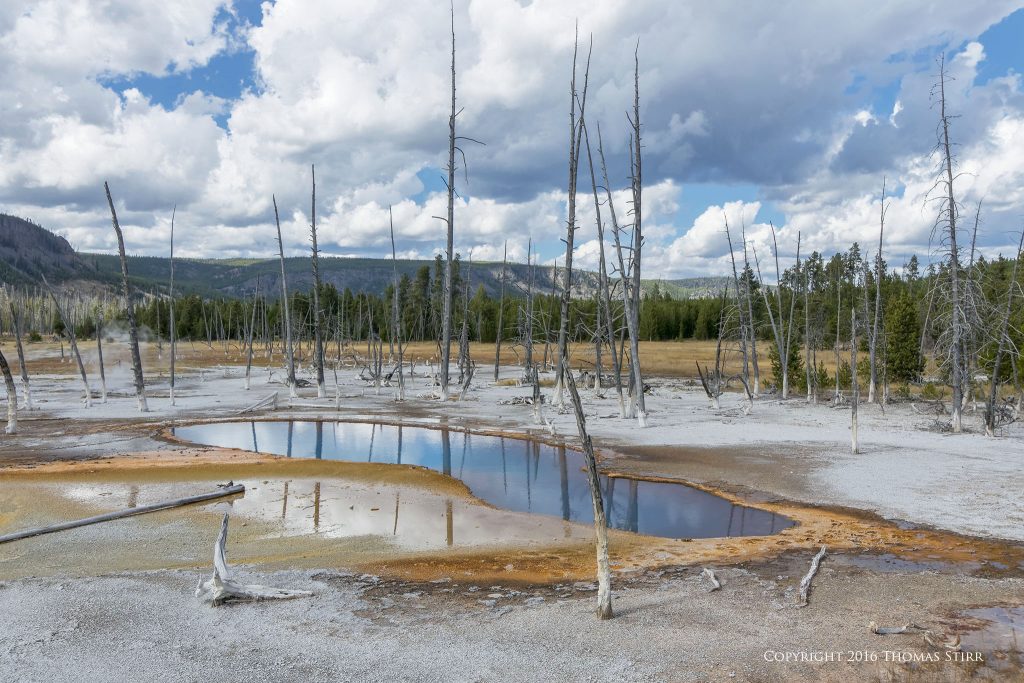
Both my wife and I found Old Faithful rather underwhelming and we were glad that we timed our visit such that we only had to spend about 20 minutes at this location in the park.
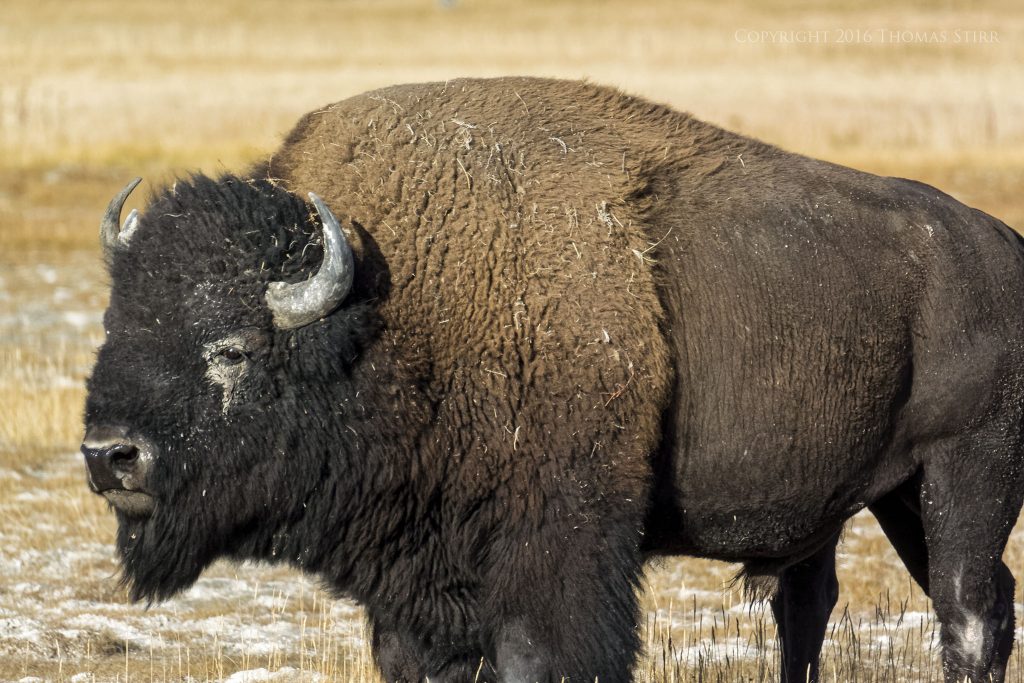
We were fortunate to see some wildlife during our visit including bison, elk, pronghorn, prairie dogs, and a coyote. Not bad for a quick afternoon visit. After Yellowstone National Park we headed south through Idaho, then on into Utah. This state was our primary photographic destination given its numerous national and state parks.
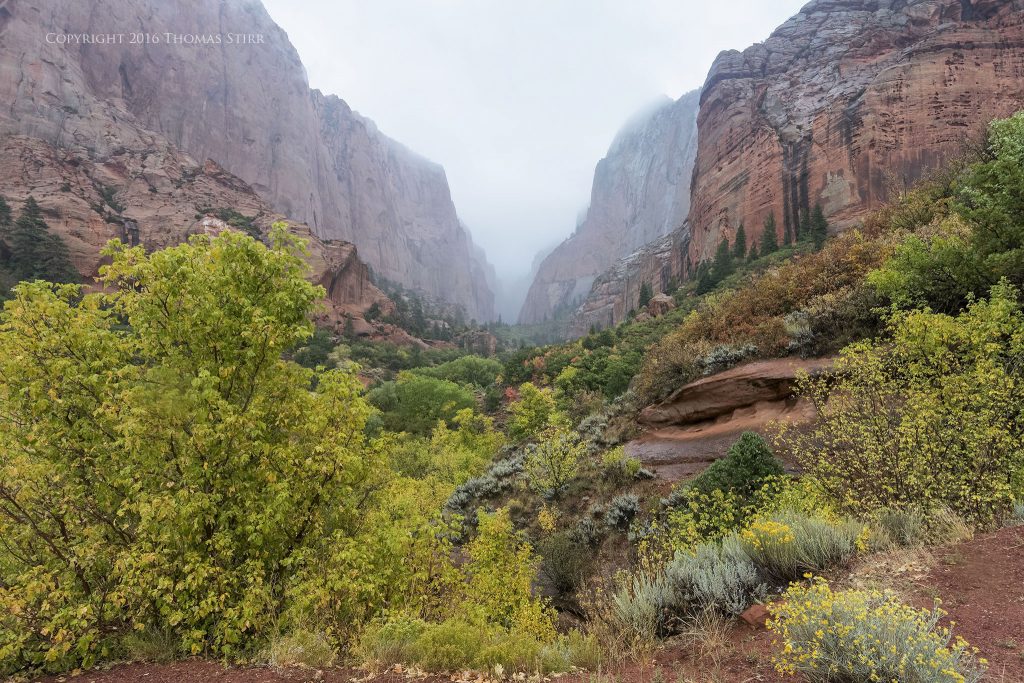
We started our Utah exploration with visits to the northern and southern portions of Zion National Park, where the image above was captured. We then headed off to Bryce Canyon National Park.

The 1 Nikon 6.7-13 mm f/3.5-5.6 zoom was used extensively while I was photographing at Bryce, and also at Zion as the wider angle zoom came in handy dealing with both tall canyon walls and wide expanses.
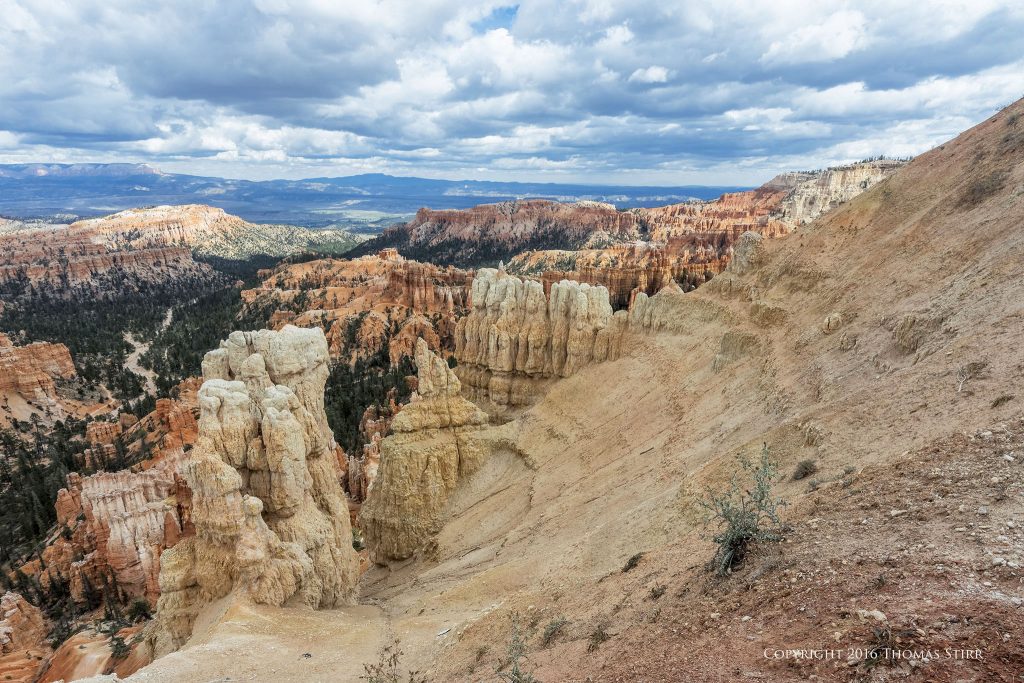
I had each lens of the Nikon 1 ‘Holy Trinity’ mounted on a different camera body. The 1 Nikon 6.7-13 mm and 10-100 mm f/4-5.6 zooms were both mounted on J5s. The CX 70-300 mm was mounted on a V2. This allowed me to very quickly switch between cameras without the need to remount lenses. As expected the 10-100 mm f/4-5.6 zoom was the workhorse of the team.
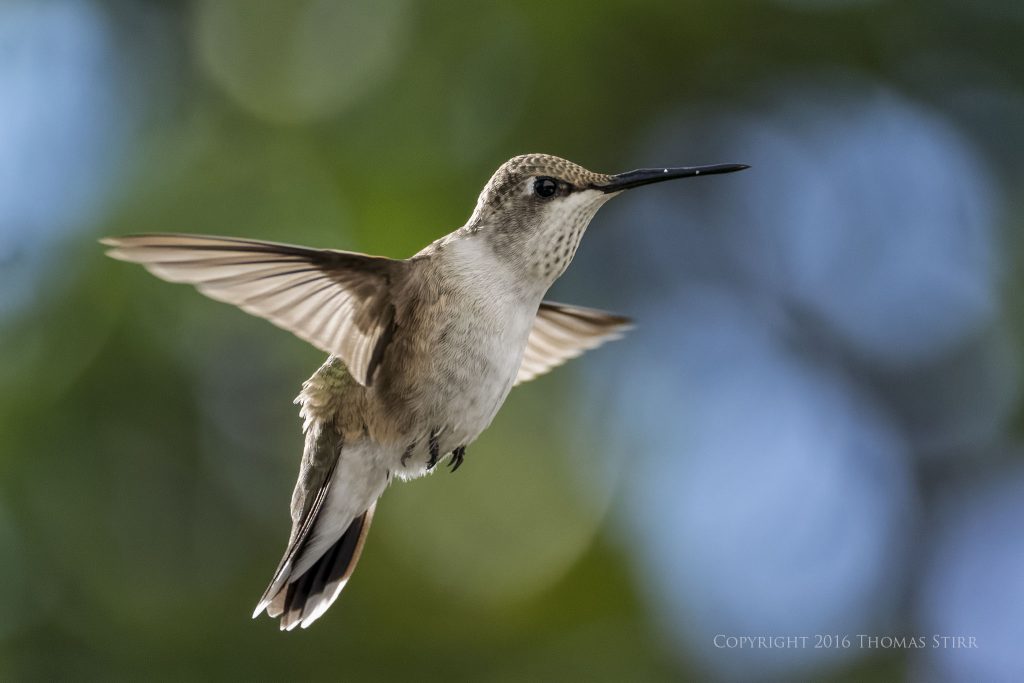
After hunkering down through a brutal thunderstorm one night in Glendale Utah, we were greeted the next morning by some migrating hummingbirds. They were quite used to being around humans so I was able to get close enough to capture this ‘full frame’ image. We learned that a tornado had touched down in a neighbouring town a few miles down the road during the storm the night before.

After spending another four days in Utah we ended up in Mexican Hat (pop 31) and visited Goosenecks State Park (image above), as well as Monument Valley.
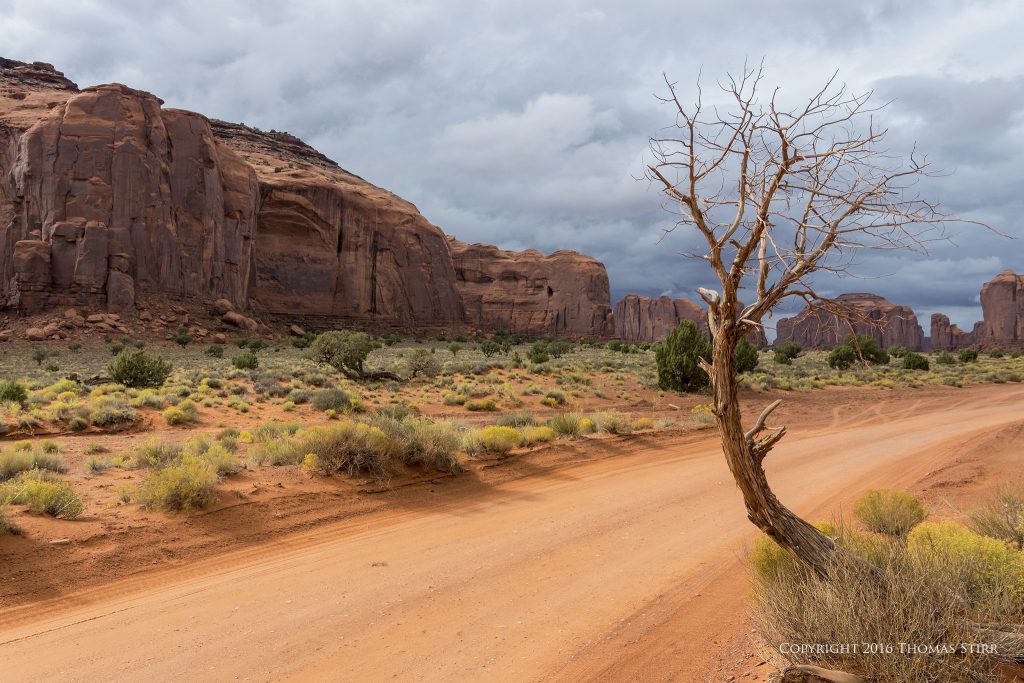
Monument Valley is a location that has been featured in numerous motion pictures over the years, from John Ford westerns, to Back to the Future, Indiana Jones, and Forest Gump to name a few.

We drove our car through the public access portion of Monument Valley. This allowed us to stop wherever we wanted to create some images. Care needs to be exercised as the dirt road can be quite rough. This is not something I would recommend doing in wet conditions, or if you have a car with very low ground clearance. My Scion xB handled the challenge well.
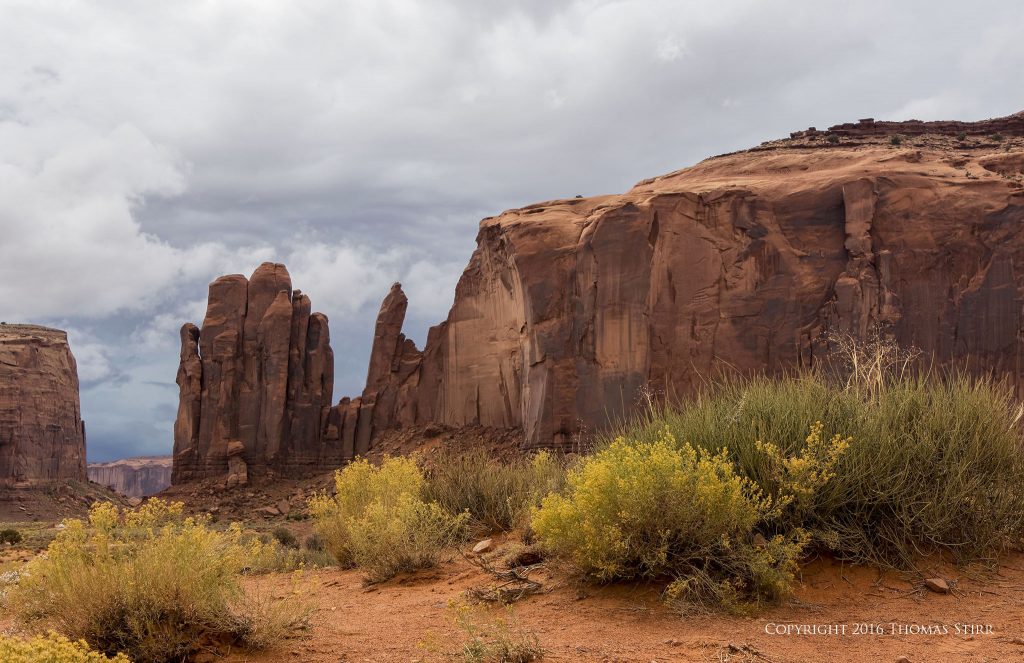
There is so much to see and photograph in Utah that one article cannot possibly do the state justice. I’ll do my best to try to put an additional additional article together to highlight some of the other Utah parks…time permitting of course.
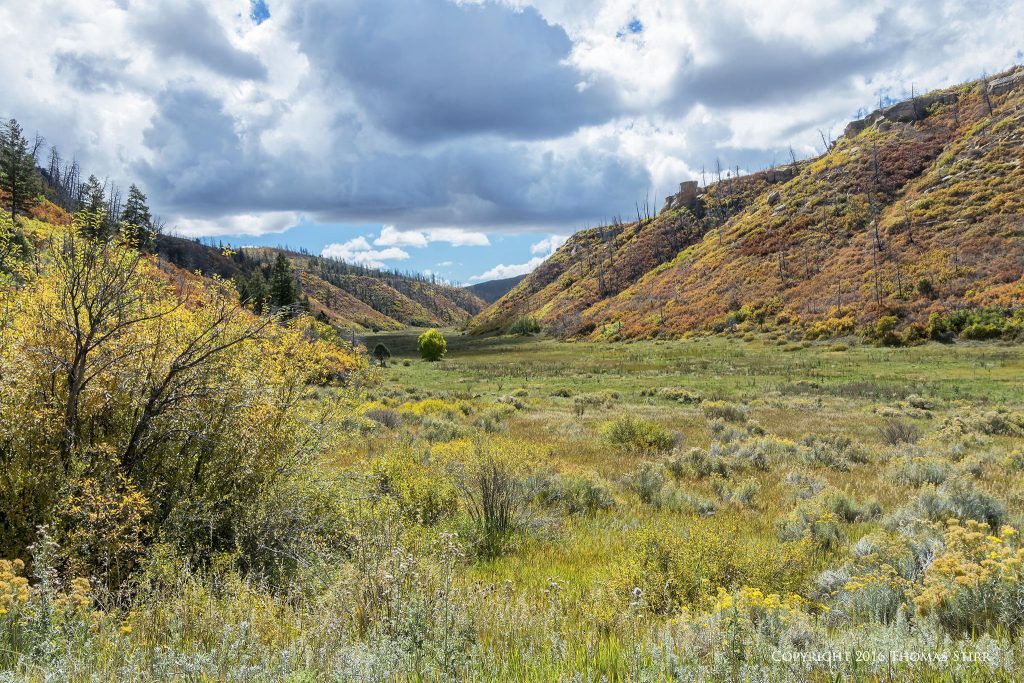
After leaving Monument Valley we headed east into southern Colorado and visited Mesa Verde National Park. This location has wonderful vistas as well as a treasure trove of historical sites. We only spent part of a day at Mesa Verde but many travellers could spend several days, if not longer, at this location.
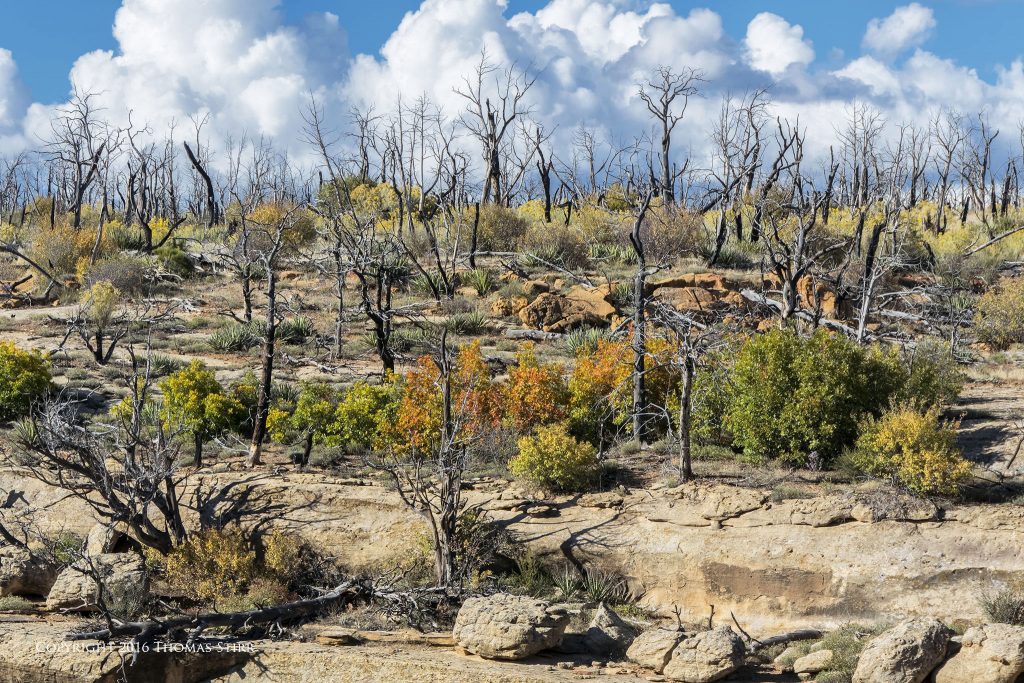
There are a few areas in the park that are recovering from previous forest fires. These sites present very unique image opportunities.

After Mesa Verde we continued east and visited Great Sand Dunes National Park. The sand dunes cover over 30 square miles and the site is one of the most unusual places I’ve visited in North America.

You are allowed to hike on the sand dunes and you can also use a sand-sled to ride down the sides of the dunes.

To get some close up views of the dunes I used my CX 70-300 mm on one of my J5s and found that the combination did a great job.
During the three weeks that I was shooting extensively with my Nikon 1 gear I found that the Nikon 1 ‘Holy Trinity’ of three zoom lenses gave me all the flexibility that I needed during the tour.
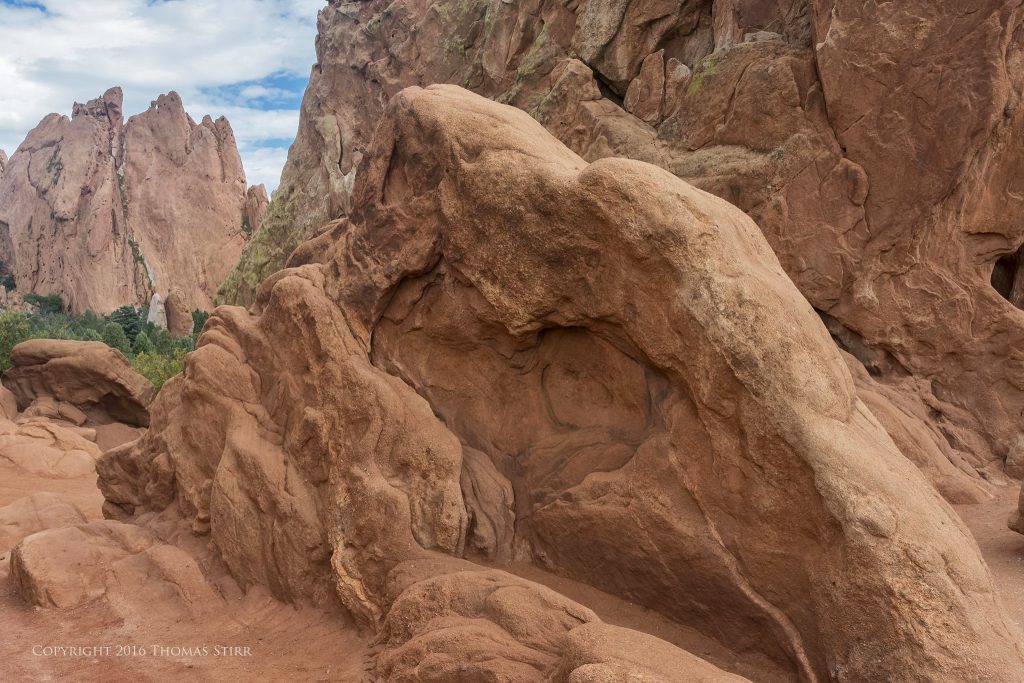
After leaving Great Sand Dunes National Park we headed north to Colorado Springs and visited the Garden of the Gods.
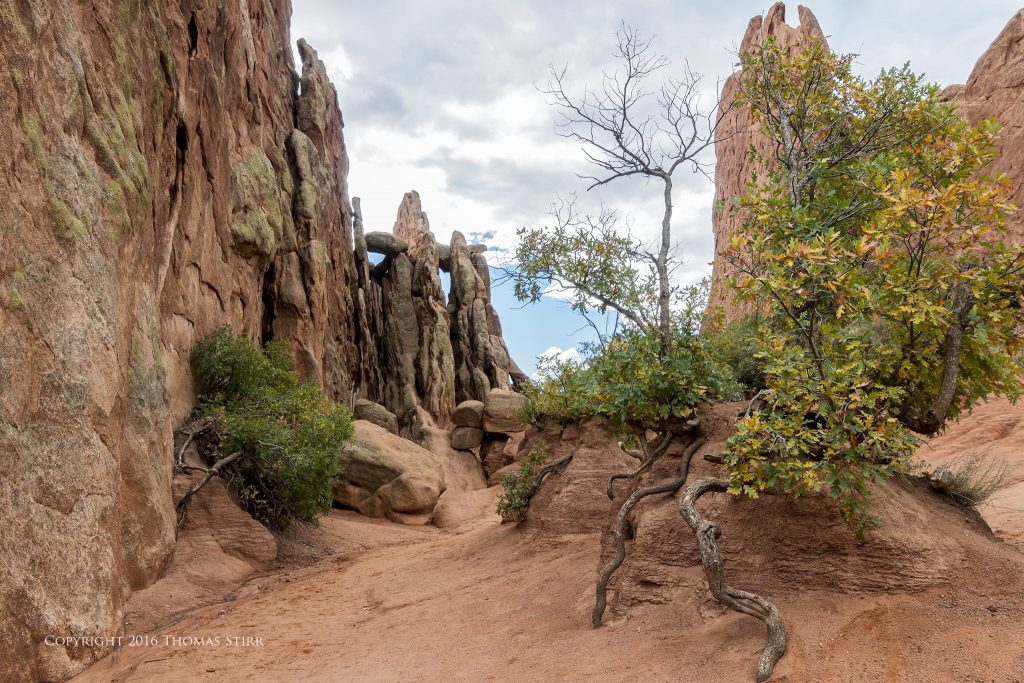
The timing of our visit probably couldn’t have been worse in terms of the size of the public crowds at the site on a Sunday afternoon. Trying to capture images without having strangers walking into frame was a significant challenge. In many cases all I had was a couple of seconds to compose my image and grab the shot. Nevertheless, I found that the Garden of the Gods was quite a pleasant photographic venue.

The final link in our photographic journey was to do the ‘grand loop’ of the Rocky Mountain National Park. My wife had read many rave reviews about this loop and we were eager to give it a try.

We came away from the experience with mixed emotions. On one hand it was quite memorable to drive north of the tree line and photograph alpine scenery. I don’t recall ever driving a vehicle at over 11,700 foot altitude before.
On the other hand, much of the drive up to the summit and back down again was about as interesting as watching paint dry. Much of the twisty road is bordered by trees close to the pavement which creates a monotonous stream of ‘sameness’. I suppose if you are partial to forest photography you may find it much more photogenic than I did.

While I initially thought I would have plenty of roadside opportunities to capture images this was not generally the case. Many of the states like South Dakota have 80-mph speed limits on the interstate highways. This makes jumping in and out of the car to grab some quick pictures quite hazardous.
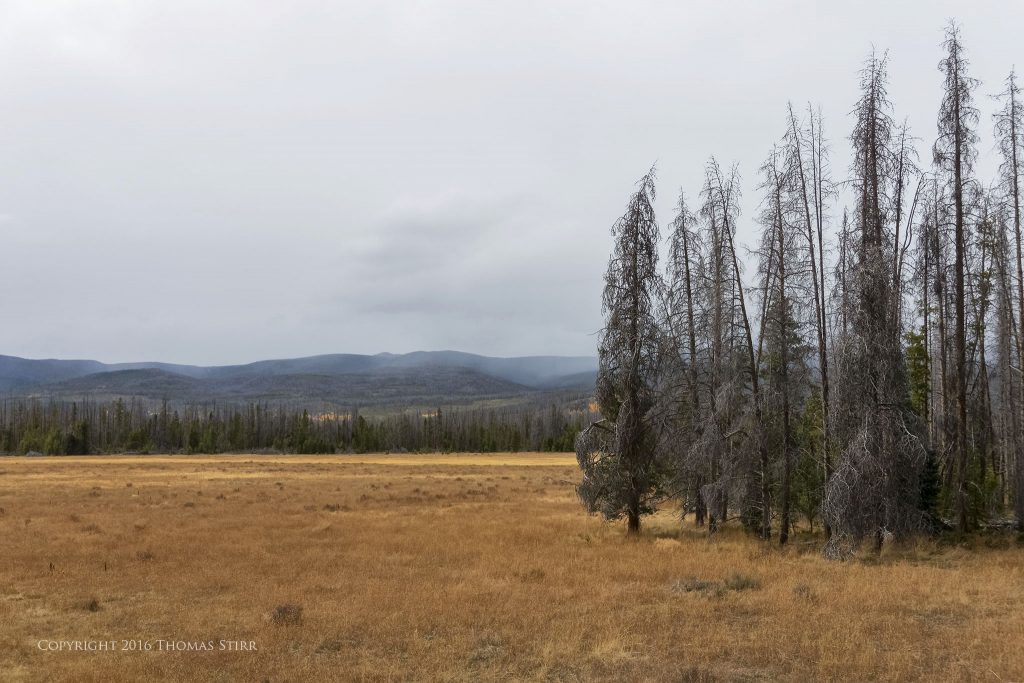
Another common issue is the lack of shoulders on many of the highways throughout this area. In many cases the shoulder is only about 1/2 meter (about 19 inches) wide. Caution and common sense are needed when attempting to capture images from the roadside.
I ended up going to the rear of the various rest stops and found that I could often capture quite reasonable and representative landscape images using this approach.
I hope you enjoyed this summary article. I’ll no doubt have a lot more blog content based on our recent photo tour in the weeks and months ahead.
If you enjoyed this article you may be interested in our eBook Desert & Mountain Memories. It is available for purchase and download for $9.99 Canadian.
My intent is to keep this photography blog advertising free. If you enjoyed this article and/or my website and would like to make a modest $10 donation through PayPal to support my work it would be most appreciated. You can use the Donate button below. Larger donations can be made to tom@tomstirr.com through PayPal.
Article and all images are Copyright 2016 Thomas Stirr. All rights reserved. No use, duplication or adaptation of any kind is allowed without written consent. If you see this article reproduced anywhere else it is an unauthorized and illegal use.

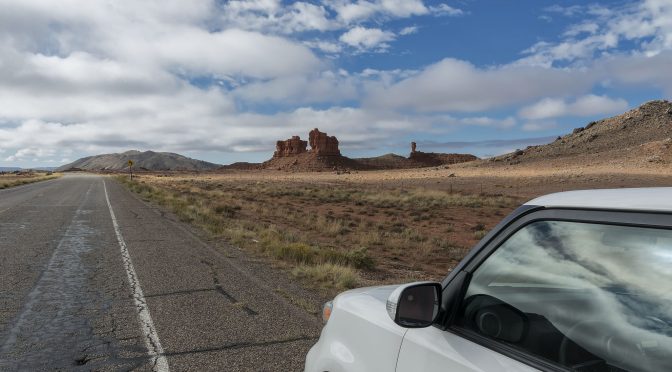

Hi Tom, really like the Hummingbird shot. Did you use just the LCD display or some customised ‘viewfinder ‘ for the photo? Like a lot of people I’m waiting for a J6 with viewfinder or a V4 with the J5 sensor specifically for use with the 70 to 300 for bird/ wildlife photography
Hi Stephen,
Thanks for helping to catch a typographical error that I made with the EXIF data! (it is now fixed) The shot was taken with a Nikon 1 V2 using the EVF. I have to enter the EXIF data manually and sometimes I copy and paste information then edit it in order to save time. In this case I made an error and did not change the camera model. My apologies!
Tom
The image looks really good considering the high ISO. I wonder how noticeable an improvement there would be with the J5 sensor considering the extra pixels and lower noise levels
Regards
Stephen
Hi Stephen,
I think there will be a noticeable difference in sharpness and detail with the J5 compared to the V2 based on comparable images I’ve taken at Bird Kingdom. Not having a low pass filter with the J5 does allow for a bit more sharpness, and the additional resolution of 20.8MP compared to 14.2MP with the V2 also makes a positive difference.
I doubt that there would be any significant difference in noise though. There is about a 2/5 of a stop difference in measured ISO between the J5 and V2 with the V2 being much closer to the manufacturer-stated ISO. For example, when the J5 is set to ISO-3200 the camera is actually shooting at ISO-1853, and the V2 when set to ISO-3200 is actually shooting at ISO-2416. So, while J5 images at the same camera ISO setting may look a little bit cleaner in terms of noise we’re not really comparing apples to apples because of the difference with measured ISO between the two cameras. In terms of low light performance, DxO rates the V2 at ISO-403 and the J5 at ISO-479. If my memory serves a difference of about 25% equals 1/3 stop…so again in terms of noise I think the difference between the two cameras is negligible.
Based on the shooting I’ve done with birds-in-flight with both the V2 and J5 the bigger issues are AF-C focus acquisition speed and buffer size. The J5 is noticeably slower than the V2 in focus acquisition speed when using AF-C and the buffer is less than half the size (about 20 images compared to about 45).
I’ve also noticed a difference between the sensors and processing engines in the J5 and V2 in terms of handling certain high contrast lighting situations. The J5, on occasion, can leave a slight ‘halo’ along high contrast edges under these conditions when shooting in jpeg. To avoid these ‘halos’ when working with RAW files I’ve found I need to change some of my software settings, particularly when using any kind of sharpness adjustments.
Tom
Hi Tom
Thanks for the detailed response. Looking at your J5 birds in flight blog I agree that the J5 looks a step up from the V2 in overall image quality. That said you still get superb results with your V2 with the big zoom. I think I’ll wait a bit longer to see what Nikon’s next move is re the J6 or V4
Regards
Stephen
Hi Stephen,
That is a prudent thing to do. I think we will see a J6 early next year. I have no idea if there will be a future V-series update or not.
Tom
Hi Tom,
Glad to see you and your wife enjoyed your trip, and the resulting photos are great!
Trivial point, was image 16 of the Hummingbird taken with the 70-300 zoom? Your notes says 10-100, but the lens focal length is shown as 300mm, 810 equivalent.
Regards, Dave R
Hi Dave,
Thanks for catching my typographical error! You are correct that the image was captured with the 1 Nikon CX 70-300mm. I have to add the EXIF data manually to all of my article images and I made a typo.
Tom
Hi Tom.
The images are really enjoyable. It must have been a very inspiring tour.
I have a question about the 10-100mm lens. Maybe it is my imagination, but it seems less “well-defined” compared to the other lenses, at least at some focal lengths like 10mm. Do you see any difference with this lens in resolution or how well-defined images are through its focal range (also compared to the other lenses)?
Looking forward to future articles from you.
Thanks.
Best regards Anders
Hi Anders,
Thanks for your comment and observations! If you can give me details on which images you have noticed the difference it will be helpful for me.
The 1 Nikon 10-100 f/4-5.6 has about the same sharpness as the 10-30mm non-PD lens. That could have been a bit of an issue on some images when compared to those captured with the 6.7-13mm. Another factor could be how I processed them. Under certain lighting conditions the J5 will produce a slight highlight ‘glow’ on jpegs. I’m not sure what causes this issue. I work from RAW files of course, but I change some of my processing details when I see that slight ‘glow’ on J5 jpegs (this does not happen with V2 files). Part of that difference is to not apply any sharpening in post on those particular images. This could be a factor, especially when comparing images captured with the 10-100mm f/4-5.6 with the 6.7-13mm.
I also shot my J5s at f/8 quite a bit during the trip so you may be noticing a bit of softening from diffraction on some images.
Glad you enjoyed the images! I have a ton of work ahead to cull through thousands of images, then process them and get them ready for inclusion into some follow up articles as well as some planned photography-related books.
Tom
Thanks for the reply Tom.
I’m sure it could be a little diffraction that makes the small difference. The reason I ask is because I have been considering the 10-100mm for a long time now, but has been a little unsure about how good it really is.
I already own the 6.7-13 mm and the 70-300 mm and they are both really great lenses. Do you think the 10-100 mm falls a little behind those lenses or do you think the difference is negligible and that it is worth “every penny” so to speak and not least due to the very versatile focal length?
Best regards Anders
Hi Anders,
I did not buy the 10-100 f/4-5.6 when it first came out since I already own the 10-100 PD zoom as well as the 30-110mm and thought that the 10-100 non-PD represented too much duplication. Many readers use the 10-100 f/4-5.6 so I decided to do a review on it. After shooting with it for several weeks and writing my review I decided to buy a copy. Since purchasing it, I’ve taken more images with the 10-100mm f/4-5.6 than any other Nikon 1 lens I own. I find the focal length range to be extremely practical and its size/weight makes it a great everyday, walk-around lens. That’s why I picked it as one of the three lenses in my Nikon 1 ‘holy trinity’. You can see that article by using this link: https://smallsensorphotography.com/nikon-1-holy-trinity
I find the 10-100 f/4-5.6 to be a very nice, practical lens for the money I do not hesitate to shoot with it.
Tom
Thanks Tom for the detailed reply. I’m quite sure now that I’ll be buying it soon.
Best regards Anders
Hi Anders,
I hope you enjoy using it as much as I enjoy using mine!
Tom
Anders,
I own all those lenses. I find the 10-100 not to be close but not sharp as either of the other 2 lenses over the middle 90% of the image. I find the corners of the 10-100 to be distinctly soft. As much as I would like to carry it as a one lens solves all, when I do something I really care about I take my 18.5 and my 30-110 between the 6.7-13 and the 70-300. The 10-100 is not a terrible lens, I personally think it’s better than either 10-30 I own. If I were forced to only take on lens I would probably chose it.
Garbled the second sentence. I find the 10-100 F/4-5.6 to be close in sharpness to the other two you mention over the middle 90% of the image. I use mine mostly as a video lens for the great zoom range.
Thanks for sharing your experiences Simon! It is always great when readers share their perspectives with each other.
Tom
Simon, thanks a lot for your thoughts on the 10-100mm. My personal favorite fixed focal length lens is the 32 mm f/1.2 and for some strange reason I haven’t used my 18.5 mm f/1.8 lens so much, but maybe I should start using it, because it is also a very good lens.
Anders,
I should say that I love my 10-100. I use it mostly to shoot video, the primary reason I got into the Nikon 1 system. I got it by mistake when I thought I was buying a used copy of the power zoom version. Store sent me the wrong model, for a great price. I love the small size, I keep it mounted on a V1 in my waist pack so I can grab it quickly while shooting stills with big DSLR’s. The build quality is excellent, like the 6.7-13. Mine takes a lot of banging when it’s around my neck and I’m working with a pair of big DSLR’s and it doesn’t show it. No zoom creep when pointing up or down. I like the manual zoom for the type of video work I do.
I love the 32mm lens. I’ve tried it in a store. So sharp. I just can’t justify that much money on a lens I wouldn’t use much. I like the 18.5 for people photos as I like to shoot family photos getting two people in the frame or waist up individually. Apart from the big 10-100, the 32 is the only lens in the system that I don’t own.
Thanks again Simon, nice to hear your experience with the 10-100 mm. I have no doubts anymore that I’ll get it and no later than my next holiday 🙂
I use the 32 mm a lot, not least because I can use it in almost any light. The images you can get with on both the V1 and the J5 are very clean and detailed even at f/1.2.
Wow what a trip that was and you captured so many lovely photo of all those wonderful natural places!
I have the Nikon V1 camera and it is my first Nikon and I am thinking my last. I have both the 10-30 and the 30-110 lens and both lens have given my trouble with “lens error” messages. So right now I have no camera to use. I have never dropped either lens nor the camera. How many times are you gotten the “lens error” message on any of your Nikon 1 lens? All are out of warranty. 🙁
Hi Joni,
Sorry to hear that you have been having some problems with your Nikon 1 gear. The original 10-30mm non-PD lens had a service notice on them. I have three copies of that lens which all went back into Nikon under the service notice. Two were repaired by Nikon and the third was deemed to be in good working order. I did not get any ‘lens error’ messages with them though…perhaps I was lucky. You may be able to get your 10-30 fixed if you bought it new and you were not aware of the service notice. I would contact Nikon to find out.
My 30-110mm was repaired under warranty by Nikon earlier this year. It had developed a ‘chattering’ sound and would not focus at certain focal lengths but is OK now after the repair. I recently bought another copy of that lens as I use it very extensively with extension tubes. My wife has been increasing her interest in photography so she will be using one of the 30-110mm lenses.
I also had my CX 70-300mm repaired under warranty as it also developed a ‘chattering’ sound. I likely use my gear far more than the average user so I wasn’t necessarily surprised that some of my equipment needed warranty service. All of my other eight Nikon 1 lenses have been trouble free and I have had no issues with any of the six Nikon 1 bodies I own.
Glad you enjoyed the images – there will be more articles and some books to come!
Tom
I did return the 10-30 lens to Nikon to be fixed using their service notice and it worked when I first got it back but now is doing the same thing again and I barely used the lens since I got it back .
I just saw this comment on another site and wonder if where I live (hot and humid south Louisiana) is part of the problem with these Nikon lenses:
“John Reid wrote:
Humidity is very bad !! Try getting away from it here in Florida ,you can’t. Not only does it ruin pictures, it ruins equipment. When I bought my NIKON F 100 , Nikon would not give me an extended warranty, because I lived in Florida!!”
Site: 21 Tips for Getting Sharper Photos | explora
– https://www.bhphotovideo.com/explora/photography/tips-and-solutions/21-tips-getting-sharper-photos?utm_medium=Email%201627696&utm_campaign=Content&utm_source=WeeklyContent%20161008&utm_content=Explora&utm_term=21-tips-getting-sharper-photos
Hi Joni,
I have also heard that living in hot, humid climates…especially when near salt water can cause premature failure of electronic equipment. Not only cameras, but appliances and televisions as well.
Tom
Tom:
Wonderful photo essay with great images of the many national parks you visited. I think the cloudy skies were really a blessing which enhanced the visual impact of the images. Many of these are worth framing for a photographic exhibit and of course core images for your planned e-books in 2017. Having seen these photographs, I feel more confident in using my 1 J5 for landscape photography. Thanks for sharing these beautiful memories of your photographic tour.
Hi Ray,
Thanks for your supportive comment! I’m glad you enjoyed the selection of photos in the article. I agree that the cloudy, menacing skies added to the mood of many of the photos. I think you will enjoy your Nikon 1 J5 and you will find that it is quite a competent camera for landscape photography.
tom